Tasmania,island state of Australia. Alan Fletcher's occasional blog about the enjoyment of birding in Tasmania.If your interest is images, visit my pbase site (see "links"). All images are copyright owned by their authors. If you wish to use any, please ask E-mail: tassiebirds@iinet.net.au
Saturday, December 31, 2005
Happy New Year
Hoping that you all received a digital camera for Christmas and your New Year's resolution is to contribute to this blog!
Raving Ravens?
During the last several weeks there has been a flock of over 100 Forest Ravens along the dunes of the South Arm Neck. While I'm used to seeing flocks of ravens during the Winter months, particularly around tips and ploughed paddocks, I can't recall a flock of this size during Summer. They seem to be having a great time cavorting in the updraughts created by the dunes. I did wonder whether this was a speed dating group!
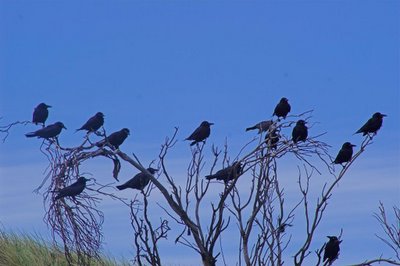

Saturday, December 24, 2005
More from Orielton Lagoon 23/12/05
Bill and I spent the morning at Orielton Lagoon banding Kelp Gull chicks and taking blood samples for DNA studies. Whilst there we also recorded 2 Cape Barren Geese, 55 Golden Plover, 47 Bar-tailed Godwit, 1 Whimbrel, 43 Eastern Curlew and c450 Red-necked Stint. Bill & Els
Tern returns?
Bill and Els saw what they thought was a marsh tern as they drove along Sharkpoint Road (northern side of the Orielton Lagoon), flying up the valley from the direction of the sewage ponds. Investigating further, they found a tern flying back and forth over the pond on the northern side of Brinktop Rd. which they identified as a White-winged (Black) Tern in non breeding plumage. They speculate that it may be the same one seen in November at Barilla Bay.
Friday, December 23, 2005
Marion bay update 22/12/05
Thought I should have a last look at Marion Bay before the onslaught of the Falls Festival, and I came back with mixed emotions. The huge area at the Southern end of the spit had been completely overtopped by recent very high tides and any attempt by the Fairy Terns to breed there would have ended in failure. In fact I did not see a single small tern. Plenty of Crested and a solitary Caspian. Along the main beach were several pairs of Pied Oystercatchers with young, at least 9 Hooded Plovers with no sign of them breeding at present and a flock of around 400 stint with 2 Turnstones. 2 Bar tails made up the list. Perhaps I should own up to having committed a cardinal sin of birders--I forgot my binos--not easy using a cameras tele lens instead. (Hooded Plover; Caspian Tern)
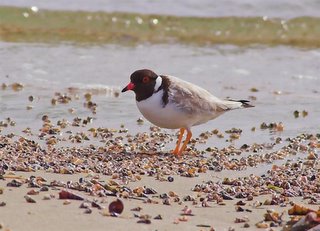



Orford Fairies
Priscilla Park made a recent trip to the Orford Spit to see how the Fairy Terns were getting on. Apparently an earlier breeding attempt had been washed out, but they were now back. Priscilla also remarked on the magnificent sight of the "fairies" hanging in the howling Sou'wester with a brilliant blue sky as their backdrop. I can only add, "where's your camera?"
Tuesday, December 20, 2005
Swampy
This time of year the harriers are hard at it feeding their young and the accompanying photos were taken today at South Arm Neck. Hunting into a stiff breeze they are probably at their most magnificent. They can be seen around much of the state during most of the warmer months, with a few, mainly juveniles, overwintering.

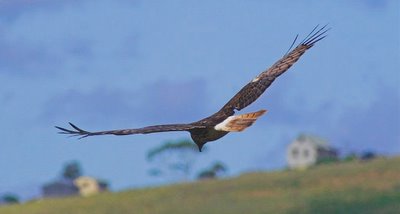
NB The apparent elongated bill on the upper picture is in fact a feather, (click to enlarge photo), the remains of a recent kill.


NB The apparent elongated bill on the upper picture is in fact a feather, (click to enlarge photo), the remains of a recent kill.
Monday, December 19, 2005
Good year for Chats?
"A Bird in the Bush"
Subtitled "A Social History of Birdwatching", written by Stephen Moss, and published by Aurum Press of London, it tells the story through from the early days, largely of the British scene, where it all started, and includes later American involvement. It does dispel my long held and uncharitable view that the reverend gentlemen who seem to have played a major part in its' beginnings, had too much time on their hands! Apparently the countryside in 18th century England was a "no go" area for most people, but the local vicar was off limits to highwaymen, footpads and the like and could wander at will. It goes on to also recount the collectors, taxidermists, oologists, the use of birds feathers in the fashion industry and the more recent improvements in optics, and many other topics. Worth a read.
NB I seem to recall reading that there was a local industry catching birds for the millinery industry. It included, if my memory is correct, catching, by netting, Azure Kingfishers in the creek that runs through Cambridge into Barilla Bay. Perhaps there's someone reading this who can verify that.
NB I seem to recall reading that there was a local industry catching birds for the millinery industry. It included, if my memory is correct, catching, by netting, Azure Kingfishers in the creek that runs through Cambridge into Barilla Bay. Perhaps there's someone reading this who can verify that.
Thursday, December 15, 2005
Orielton Lagoon Update 15/12/05
No sooner than I blog a piece about Orielton than a few more notable birds rear their head. Among the 40+ Curlew and c80 Bar-tailed Godwit are a solitary Whimbrel and the reappearance of the 2 Great Knot. I suspect the best time to find them will be at High Tide at Sorell--appears to be have been around 11am today. The waders are "driven" into Orielton to roost. If you want to see them you WILL need gumboots, and something to wrap them in on returning to your car! Orielton mud is infamous. You will also have to endure the Kelp Gulls, as they have, or are in the course of hatching their young--at a guesstimate there are 50+prs breeding. The Curlew and B/tails normally roost on the waters edge towards the end of the spit that runs out into the lagoon, usually readily seen from the road. A scope would be very useful.
17/12/05 2 Cape Barren Geese have turned up at this site.

17/12/05 2 Cape Barren Geese have turned up at this site.

If you'd only stay still you could be lunch!
Kelp Gull chick with over eager Silver Gull
Kelp Gull chick with over eager Silver Gull
Wednesday, December 14, 2005
In Search of GPs
 There aren't many places in the southern parts of the state where Golden Plover can invariably be found, at least during the warmer months, but Orielton Lagoon is still your best chance. I recently (last weekend) counted 96 there. If you go into the reserve from the Shark Point-Sorell Road end, they can usually be seen in what for many years was called"Tank Corner", that is, close to the golf course on the Midway Point side. As a bonus, you may find the odd Sharptailed Sandpiper embedded in the flock. They are usually fairly difficult to get close too, and if you persist they will take flight and leave the lagoon altogether. If there has been rain during the preceding week,(or you intend to walk close to the water) you'll be advised to wear gum boots! This is one place a scope is a more than useful accoutrement. I have attached some, albeit fairly poor quality, photographs taken on my trip--you can see I couldn't get very close and , in case you're wondering, they were still there when I left.
There aren't many places in the southern parts of the state where Golden Plover can invariably be found, at least during the warmer months, but Orielton Lagoon is still your best chance. I recently (last weekend) counted 96 there. If you go into the reserve from the Shark Point-Sorell Road end, they can usually be seen in what for many years was called"Tank Corner", that is, close to the golf course on the Midway Point side. As a bonus, you may find the odd Sharptailed Sandpiper embedded in the flock. They are usually fairly difficult to get close too, and if you persist they will take flight and leave the lagoon altogether. If there has been rain during the preceding week,(or you intend to walk close to the water) you'll be advised to wear gum boots! This is one place a scope is a more than useful accoutrement. I have attached some, albeit fairly poor quality, photographs taken on my trip--you can see I couldn't get very close and , in case you're wondering, they were still there when I left.
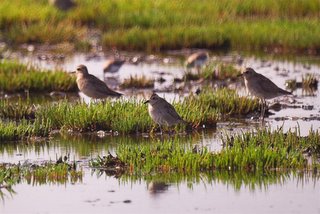
Saturday, December 10, 2005
Much sought after 'tick" for some
Bruce Lord rang me this morning (Saturday) to tell me that a Masked Owl had taken up residence in a Sandy Bay garden and would I be interested in photographing it. I must say my first thoughts were that it would probably be hidden in dense foliage and difficult to see, let alone photograph. However, I certainly don't see Masked Owls that often that I could pass up the opportunity, so armed with camera I set off. I was pleasantly surprised to find the female Masked in the open and photographable, although against a bright sky. Bruce mentioned that he knew of at least one Mainlander who would be on the next aircraft to Tasmania, if he thought the bird would remain here--apparently a much sought after sighting. The bird has been at this residence for at least 10 days. It may have been displaced from a local park that is undergoing major works.
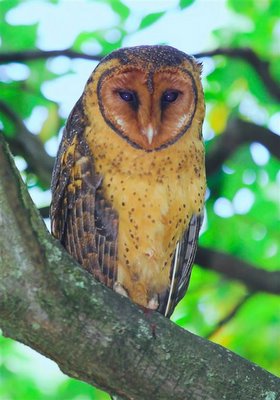



Friday's notables
Just over 1600 Mountain Duck at Lake Dulverton today, along with the Banded Stilt.
There were 4 Blue-billed Duck at the dam at Bothwell.
Nothing else of particular interest ornithologically speaking, but the yellow everlasting daisies and other wildflowers were fantastic. Bill & Els
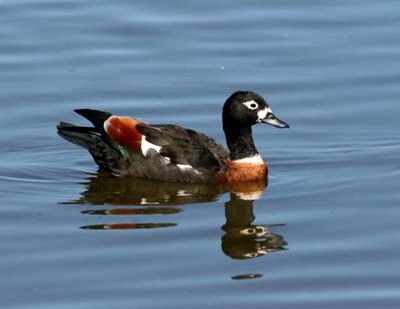
Psst.....all the others are up at Dulverton.
There were 4 Blue-billed Duck at the dam at Bothwell.
Nothing else of particular interest ornithologically speaking, but the yellow everlasting daisies and other wildflowers were fantastic. Bill & Els

Psst.....all the others are up at Dulverton.
Friday, December 09, 2005
Marion Bay Terns
Once the terns choose their spot to colonise, there will be a need to fence the area. If any one is down there--Marion Bay Spit-- in the next few days/week or so, please let me (Priscilla) know if breeding has commenced. Last year illegal 4WDers smashed the fence down and threw the signs into the dunes. Priscilla Park
.....more Frogmouths.
Some of my family visited Taroona recently for a Scouts outing, and came back boasting about the Tawny Frogmouths they'd seen. Up until then we hadn't added them to our Tassie list, though we had seen lots on the Mainland.
My wife and I went to check them out, and sure enough, this little family of Frogmouths was still there--even on the same branch! The family were roosting in a small gum tree in the grounds of the Taroona Fire Station, and were low enough for easy photography.
'Mum and Dad' were trying their best to look like dead branches, but the 'kids' just didn't seem to have any idea. They were far more inquisitive about intruders, looking back at those watching them. Just as well the parents kept them hemmed in to keep a close, if almost closed, eye on them. John Tongue.
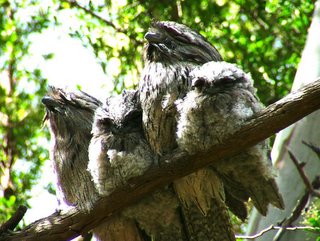

My wife and I went to check them out, and sure enough, this little family of Frogmouths was still there--even on the same branch! The family were roosting in a small gum tree in the grounds of the Taroona Fire Station, and were low enough for easy photography.
'Mum and Dad' were trying their best to look like dead branches, but the 'kids' just didn't seem to have any idea. They were far more inquisitive about intruders, looking back at those watching them. Just as well the parents kept them hemmed in to keep a close, if almost closed, eye on them. John Tongue.


Wednesday, December 07, 2005
New Sightings 6/12/05
Bill reports that there are now 2 Sanderlings at Marion Bay as well as the previously reported waders. He also says that there may be at least one nest in the area around the Spit, as there was one bird acting aggressively and that the remaining 25 Fairy and 1 Little Terns were favouring the Spit area. I noted that several of the terns seemed interested in an area of shell grit near the Spit end and that close by there was a Pied Oystercatcher nest. Any one venturing down there should exercise caution in this vicinity.
There has been a report of 15 Japanese Snipe at Lake Dulverton, and should be worth following up.
There has been a report of 15 Japanese Snipe at Lake Dulverton, and should be worth following up.
Tuesday, December 06, 2005
Marion Bay revisited again! 6/12/05
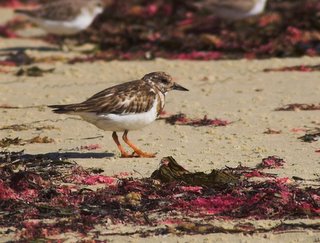
 Unbeknown to me, Bill & Els had visited here the previous day. However my interest was still to find some 'hoodies' to photograph. I found most of the same things as B&E, but missed out on the Sanderling. On the credit side, I did see the c70 Bar-tails. There was a strong onshore wind making photography difficult, and the photographs of the hoodies were somewhat less than I was hoping for, but I was luckier with the, turnstones, plover and tern. Also on the ocean beach were c200 Red-necked Stint feeding among the seaweed, and a beachwashed Gannet , Diving Petrel and 25+ Short-tails.
Unbeknown to me, Bill & Els had visited here the previous day. However my interest was still to find some 'hoodies' to photograph. I found most of the same things as B&E, but missed out on the Sanderling. On the credit side, I did see the c70 Bar-tails. There was a strong onshore wind making photography difficult, and the photographs of the hoodies were somewhat less than I was hoping for, but I was luckier with the, turnstones, plover and tern. Also on the ocean beach were c200 Red-necked Stint feeding among the seaweed, and a beachwashed Gannet , Diving Petrel and 25+ Short-tails.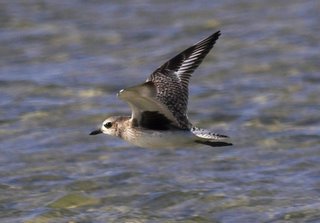
 The Grey Plover has these black 'underarm' markings, seen in flight, which are diagnostic of the Grey vs. Golden Plovers.
The Grey Plover has these black 'underarm' markings, seen in flight, which are diagnostic of the Grey vs. Golden Plovers.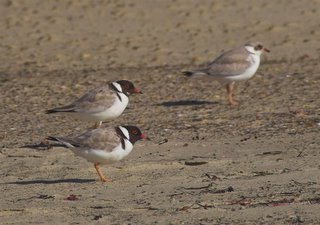
The 3 Hooded Plovers seen here were part of a small group of 5 birds, 4 adult and one juvenile on the main beach.
Marion Bay revisited 5/12/05
We went to Marion Bay again, and the first bird of note was a solitary Sharp-tailed Sandpiper on the marsh in the centre of the trotting track by the causeway. Also present was c60 Pied Oystercatcher, one carrying 3 colour bands on one leg, but too far away to determine the combination.
Could it be that the increase in the numbers of P.O.s at Lauderdale and South Arm are mainland birds. A considerable number of colour banded birds have been seen on King Island. If observers have the chance to read the colour combination of this or other birds, it could prove interesting.
Out on the Spit there were other good finds in the form of a Grey Plover, a single Sanderling and 26 fairy Terns. Along the ocean beach a lot more seaweed than usual had attracted 3 Ruddy Turnstone, which we almost walked past before they got up and walked a little further up the beach to allow us to walk by. Only 2 Bar-tails were located, with none found elsewhere in the bay.
A further search for the 3 Canada Geese recorded by Andrew and Cynthia Meyles in the middle of last month, between Dunalley and Marion Bay, proved unsuccessful. (Having seen the impact that large numbers of Canada Geese have had overseas, I wish them a short life!ed) Bill & Els
NB Bill tells me the "Canada Geese", turned out to be Swan or Chinese Geese--a little premature in wishing them short lives!
Could it be that the increase in the numbers of P.O.s at Lauderdale and South Arm are mainland birds. A considerable number of colour banded birds have been seen on King Island. If observers have the chance to read the colour combination of this or other birds, it could prove interesting.
Out on the Spit there were other good finds in the form of a Grey Plover, a single Sanderling and 26 fairy Terns. Along the ocean beach a lot more seaweed than usual had attracted 3 Ruddy Turnstone, which we almost walked past before they got up and walked a little further up the beach to allow us to walk by. Only 2 Bar-tails were located, with none found elsewhere in the bay.
A further search for the 3 Canada Geese recorded by Andrew and Cynthia Meyles in the middle of last month, between Dunalley and Marion Bay, proved unsuccessful. (Having seen the impact that large numbers of Canada Geese have had overseas, I wish them a short life!ed) Bill & Els
NB Bill tells me the "Canada Geese", turned out to be Swan or Chinese Geese--a little premature in wishing them short lives!
Peter Murrell Reserve--Coffee Creek 4/12/05
The Tawny Frogmouth nest that Tas Boskell told us about was found and photographed (see pic) . Tas had mentioned that it was to be found at the East end of the dam wall as you cross the little creek leading out of the dam nearest the car park. The mate of the brooding bird was sitting within 3 metres of the track and only briefly opened one eye. The large chick did momentarily put on a display of yawning, but that was it as far as major action was concerned! Bill & Els
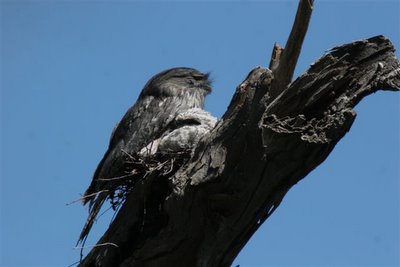
Peter Murrell reserve is situated at Kingston just to the South of the roundabout just past the Antarctic Div HQ. It's a good spot to find endemics.

Peter Murrell reserve is situated at Kingston just to the South of the roundabout just past the Antarctic Div HQ. It's a good spot to find endemics.
Saturday, December 03, 2005
Iron Pot and Betsy Island 2/12/05
 Had a great day visiting the Iron Pot and circumnavigating Betsy Island. This year the Black-faced Cormorants and Silver Gulls have all moved fron the Iron pot and Little Betsy Is.. The Black-faced Cormorants breeding colonies are on the East face of 'Big' Betsy, where there are over 800 adults and young in 3 colonies on cliffs painted white with guano. The Silver Gulls are on the South eastern corner of the island overlooking Little Betsy.
Had a great day visiting the Iron Pot and circumnavigating Betsy Island. This year the Black-faced Cormorants and Silver Gulls have all moved fron the Iron pot and Little Betsy Is.. The Black-faced Cormorants breeding colonies are on the East face of 'Big' Betsy, where there are over 800 adults and young in 3 colonies on cliffs painted white with guano. The Silver Gulls are on the South eastern corner of the island overlooking Little Betsy.One pair of Caspian Terns are nesting on the Iron Pot--the only species of tern breeding there, though there are both Pacific and Kelp Gulls breeding there and look to have a firm foothold.
The Islands are particularly beautiful at the moment with pigface flowering over extensive areas. Bill & Els
NB The Iron Pot is at the mouth of the Derwent River and the Betsy Islands are situated to the East lying off Goat Bluff and Black Jack Rocks.
Digital photography
Not sure how much readers know about digital photography, no doubt it ranges from a lot to no interest. I don't claim to be an expert, but I do have a fair idea about equipment needed, what you can expect to achieve and not least, what it might cost. On that subject, if you are or have been using a film based Single Lens Reflex (SLR) you're half way there. If readers are interested, I'll blog something or if you add comments below, I'll address those issues. If you want something more personalised, I'll e-mail or even phone! Look forward to your comments.
If you're already a digital photographer, but like me still in the learning stage, you might find the post on "Illinois Birds" (Link on this page) about the merits of using RAW and Raw Shooter interesting.
If you're already a digital photographer, but like me still in the learning stage, you might find the post on "Illinois Birds" (Link on this page) about the merits of using RAW and Raw Shooter interesting.
Hoodies at Marion Bay
Sadly the numbers of Hoodies at Marion Bay have declined. There used to be 4prs at the entrance from the car park, now only one. I believe there are 2 prs at the southern end and odd ones going north. They will have to contend with the Falls Festival! Despite the fact that dogs/owners have to stay within the dog exercise area, last year very little control. [evidence of dogs having been in "forbidden" zone on 28/11/05 ed.] Pity there aren't more decomposing whales--might keep them off the beach! Priscilla P.
Friday, December 02, 2005
Gould's Lagoon 2/12/05
 Gould's Lagoon is certainly worth a trip anytime, and at the moment one of the 'signature' birds, the Reed Warbler is particularly active and vocal. On arrival fairly early morning, the sound of Reed Warblers calling was the first sound to greet me. I couldn't see any of the several birds calling,
Gould's Lagoon is certainly worth a trip anytime, and at the moment one of the 'signature' birds, the Reed Warbler is particularly active and vocal. On arrival fairly early morning, the sound of Reed Warblers calling was the first sound to greet me. I couldn't see any of the several birds calling,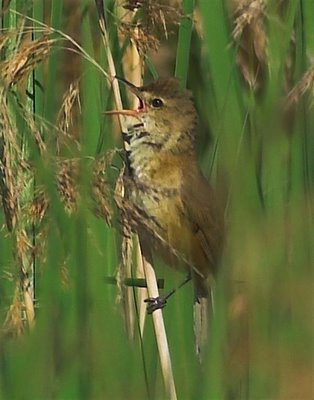
but patience was eventually rewarded. Admittedly most of the views were fleeting, but I managed to take a few shots, seen here. Also present were Coot, Chestnut Teal, Black Duck, Swamphen and Native Hen. Heard calling, but not sighted were several Little Grassbirds. Gould's is often worth at least a passing visit, in the past it has managed to attract such unlikely species as Black-tailed Native Hen and Little Ringed Plover. I can particularly remember the plover, as Mike Newman rang me up to tell me that it had been seen there. However it was the 1st of April and it took him a long time to convince me it wasn't an April Fool's joke!! The Shore Bird Study Group unsuccessfully attempted to mist net it. Other species present at times are a list of duck and crakes. A little more ominous, I feel, is the presence of a pair of nesting Kelp Gulls. They presently have 2 young, being reared on the top of a duck nesting box.
All together I recorded 26 species in approx. an hour. I have appended a couple of additional shots of the reed warbler.


Who's watching who?
 Bill W. had told me he has a hide at Prosser's Dam, so returning from a recent trip (2/12) I decided to have a look at it out of curiosity. As I neared the dam, screened from my view by young trees, I noticed the unmistakable outline of a Sea Eagle, sitting in the top of a dead tree, usually frequented by cormorants. Driving a little further and the hide came into view--situated at the base of the self same dead tree! I assume Bill wasn't in it, and even if he had been I doubt whether he would have been aware of the eagle.
Bill W. had told me he has a hide at Prosser's Dam, so returning from a recent trip (2/12) I decided to have a look at it out of curiosity. As I neared the dam, screened from my view by young trees, I noticed the unmistakable outline of a Sea Eagle, sitting in the top of a dead tree, usually frequented by cormorants. Driving a little further and the hide came into view--situated at the base of the self same dead tree! I assume Bill wasn't in it, and even if he had been I doubt whether he would have been aware of the eagle. While in the area I took the White Kangaroo Rd, to see if I could find any sign of the Masked Woodswallows reported there by Cynthia and Andrew Meyles on the 19th of last month. I did see a 'dusky', but no sign of the masked. Well worth keeping an eye out for these, I doubt whether they've left the area.
While in the area I took the White Kangaroo Rd, to see if I could find any sign of the Masked Woodswallows reported there by Cynthia and Andrew Meyles on the 19th of last month. I did see a 'dusky', but no sign of the masked. Well worth keeping an eye out for these, I doubt whether they've left the area.
Monday, November 28, 2005
A Piece of Self Indulgence
Marion Bay Monday 28/11/05
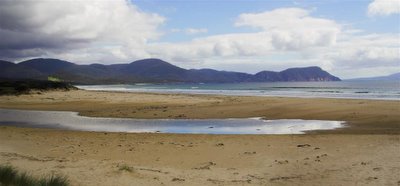
I came across the flock of c70 Bar-tailed Godwit alluded to by Bill W. in the pelagic blog. They were feeding at the mouth of Blackman Bay as the tide receded and I have appended a few of the photos taken.

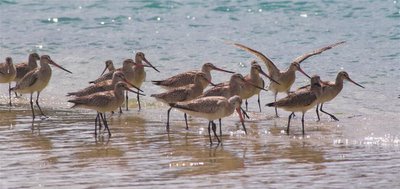

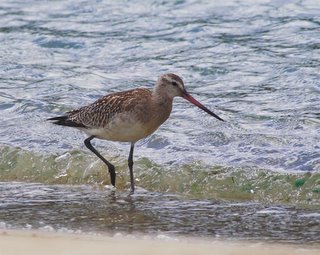
I was able to approach within 20metres or less to take these. Ironically I had gone to Marion Bay to photograph Hooded Plovers, but I didn't even manage to find a single bird. I have always been able to find them in the past and have caught and banded adults and juveniles here . Was I just unlucky or have numbers declined here?

I came across the flock of c70 Bar-tailed Godwit alluded to by Bill W. in the pelagic blog. They were feeding at the mouth of Blackman Bay as the tide receded and I have appended a few of the photos taken.




I was able to approach within 20metres or less to take these. Ironically I had gone to Marion Bay to photograph Hooded Plovers, but I didn't even manage to find a single bird. I have always been able to find them in the past and have caught and banded adults and juveniles here . Was I just unlucky or have numbers declined here?
Marion Bay Pelagic Trip
Last Sunday's (27/11) pelagic trip left from Dunnalley rather than the usual Eaglehawk Neck and was a pretty quiet and comfortable trip for the participants. However the absence of wind was the probable cause of the relatively few birds being sighted.
The one bird that bears comment was a single Golden Plover seen circling the boat while they were 15km offshore. Bill W. at first thought that someone was imitating the GPs call, until someone saw a wader that gave excellent views and allowed positive ID.
 Observations included: 1 Southern Giant Petrel, 1 Northern Giant Petrel, 1 White-chinned Petrel, 3 Southern Royal Albatross, 2 imm & 1 ad. Black-browed Albatross, c50 Shy Albatross, c3 Yellow-nosed Albatross, 2 Buller's Albatross as well as Gannets, Short-tailed Shearwater, Crested Tern, Kelp Gull and Black-faced Cormorant. Inshore species included Pelican and c70 Bar-tailed Godwit.
Observations included: 1 Southern Giant Petrel, 1 Northern Giant Petrel, 1 White-chinned Petrel, 3 Southern Royal Albatross, 2 imm & 1 ad. Black-browed Albatross, c50 Shy Albatross, c3 Yellow-nosed Albatross, 2 Buller's Albatross as well as Gannets, Short-tailed Shearwater, Crested Tern, Kelp Gull and Black-faced Cormorant. Inshore species included Pelican and c70 Bar-tailed Godwit.
The one bird that bears comment was a single Golden Plover seen circling the boat while they were 15km offshore. Bill W. at first thought that someone was imitating the GPs call, until someone saw a wader that gave excellent views and allowed positive ID.
 Observations included: 1 Southern Giant Petrel, 1 Northern Giant Petrel, 1 White-chinned Petrel, 3 Southern Royal Albatross, 2 imm & 1 ad. Black-browed Albatross, c50 Shy Albatross, c3 Yellow-nosed Albatross, 2 Buller's Albatross as well as Gannets, Short-tailed Shearwater, Crested Tern, Kelp Gull and Black-faced Cormorant. Inshore species included Pelican and c70 Bar-tailed Godwit.
Observations included: 1 Southern Giant Petrel, 1 Northern Giant Petrel, 1 White-chinned Petrel, 3 Southern Royal Albatross, 2 imm & 1 ad. Black-browed Albatross, c50 Shy Albatross, c3 Yellow-nosed Albatross, 2 Buller's Albatross as well as Gannets, Short-tailed Shearwater, Crested Tern, Kelp Gull and Black-faced Cormorant. Inshore species included Pelican and c70 Bar-tailed Godwit.
Friday, November 25, 2005
Risdon Brook Dam

I can't say that I'm a great fan of Risdon Brook Dam reserve. I don't really like "sharing" my birding with runners, power walkers, and mothers with strollers, to name a few. But recently, in the USA, I have seen the merits of "multi use preserves". One benefit is that the birds become used to the presence of humans and are more approachable--well some are. So, on Thursday,25/11, armed with a camera I made a trip to Risdon. A few photos are shown here. My total species list was 36, although conceivably I've missed a few. Although it has a largish body of water, the only water related species I recorded were Hoary-headed Grebe, Black Duck and White-faced Heron. Flame, Scarlet and Dusky Robins were present as were Pallid, Fantailed and Horsfield Bronze Cuckoos. Sulphur crested, Swift Parrot, Green and Eastern Rosellas were also there. A small group of Dusky Woodswallows and the only honeyeaters were Little and Yellow Wattlebirds, Yellow throats and the inevitable Noisy Miners. There was also abundant Yellow rumped Thornbills and more modest numbers of Browns. Large numbers of Welcome swallows, mostly juveniles, were hawking over the water and surrounds.
 This White-faced Heron sat on the dam fence and allowed close approach. Well I did have to coax it to get up on the fence! The whole walk took only one and a half hours. Risdon brook Dam is situated near Risdon Vale opposite the prison. It's open from 8.30am to 9.00pm, although this will vary with time of year.
This White-faced Heron sat on the dam fence and allowed close approach. Well I did have to coax it to get up on the fence! The whole walk took only one and a half hours. Risdon brook Dam is situated near Risdon Vale opposite the prison. It's open from 8.30am to 9.00pm, although this will vary with time of year. One of a few pipits seen on the western shore of the dam.
One of a few pipits seen on the western shore of the dam.
 One of many swallows around perimeter of lake.
One of many swallows around perimeter of lake.
Thursday, November 24, 2005
Trip to Spectacle Island
 Bill and Els took a boat trip to Spectacle Island on the 23rd Nov--Spectacle Island is just off Dodges Ferry. While having lunch on the boat anchored near the island there was an almighty commotion with great clouds of birds, mostly Crested Terns and Silver Gulls, wheeling above the island. Looking around they found the culprit--a Sea Eagle floating past having come from the direction of Woody Island, where there is an eyrie. The eagle passed over and drifted off toward Primrose Sands without taking any great interest in Spectacle. Large numbers of chicks are present on the island, the oldest being about 2 weeks old and keeping well under cover!!
Bill and Els took a boat trip to Spectacle Island on the 23rd Nov--Spectacle Island is just off Dodges Ferry. While having lunch on the boat anchored near the island there was an almighty commotion with great clouds of birds, mostly Crested Terns and Silver Gulls, wheeling above the island. Looking around they found the culprit--a Sea Eagle floating past having come from the direction of Woody Island, where there is an eyrie. The eagle passed over and drifted off toward Primrose Sands without taking any great interest in Spectacle. Large numbers of chicks are present on the island, the oldest being about 2 weeks old and keeping well under cover!!
Saturday, November 12, 2005
Tuesday, June 07, 2005
Tasmanian Species List
Lists Commoner Species (Highlighted photo links)
Family Podicipedidae
Hoary-headed Grebe, Poliocephalus poliocephalus
Australasian Grebe, Tachybaptus novaehollandiae
Great-crested Grebe,Podiceps cristatus
Family Pelecanidae
Australian Pelican, Pelecanus conspicillatus
Family Sulidae
Australasian Gannet, Morus serrator 2
Family Phalacrocoracidae
Black-faced Cormorant, Phalacrocorax fuscescens
Great Cormorant, Phalacrocorax carbo
Little Pied Cormorant, Phalacrocorax elanoleucos
Little Black Cormorant, Phalacrocorax sulcirostris
Family Ardeidae
White-faced Heron, Egretta novaehollandiae
Cattle Egret, Ardea ibis
Australasian Bittern, Botaurus poiciloptilus
Great Egret, Ardea alba 2
Little Egret, Egretta garzetta
Intermediate Egret, Egretta intermedia
Nankeen Night Heron, Nycticorax caledonicus
Family Anatidae
Hardhead, Aythya australis
Chestnut Teal, Anas castanea 2
Grey Teal, Anas gracilis
Australasian Shoveler, Anas rhynchotis 1 2
Pacific Black, Anas superciliosa
Musk Duck, Biziura lobata
Cape Barren Goose, Cereopsis novaehollandiae
Australian Wood Duck, Chenonetta jubata
Black Swan, Cygnus atratus
Blue-billed Duck, Oxyura australis
Australian Shelduck, Tadoma tadornoides
Family Accipitridae
Collared Sparrowhawk, Accipter cirrhocephalus
Brown Goshawk, Accipiter fasciatus
Grey Goshawk, Accipiter novaehollandiae
Swamp Harrier, Circus approximans,
Whistling Kite, Haliastur sphenurus
White-breasted Sea Eagle, Haliaeetus leucogaster2
Wedge-tailed Eagle, Aquila audax (Rare/Threatened) 2
Family Falconidae
Brown Falcon, Falco berigora
Australian Kestrel, Falco cenchroides
Australian Hobby, Falco longipennis
Peregrine Falcon, Falco perigrinus
Family Turnicidae
Painted Button-quail, Turnix varia
Family Phasianidae
Brown Quail, Coturnix ypsilophora
Stubble Quail, Coturnix pectoralis (novaezealandiae)
Family Rallidae
Eurasian Coot, Fulica atra
Tasmanian Native Hen, Gallinula mortierii (Endemic) 2
Dusky moorhen, Gallinula tenebrosa,
Purple Swamphen Porphyrio porphyrio
Australian Crake, Porzana fluminea
Baillons Crake, Porzana pusilla
Spotless Crake, Porzana tabuensis
Lewins Rail, Rallus pectoralis
Buff-banded Rail, Rallus philippensis
Family Haematopodidae
Pied Oystercatcher, Haematopus longirostris
Sooty Oystercatcher, Harmatopus fuliginosus 2 3
Family Charadriidae
Double-banded Plover, Charadrius bicinctus
Black-fronted Dotterel, Elseyornis melanops
Lesser srand Plover, Charadrius mongolus
Hooded Plover, Thinornis rubricollis 1
Red-capped Plover, Charadrius ruficapillus1 2
Red-kneed Dotterel, Erythogonys cinctus
Pacific Golden Plover, Pluvialis fulva 2
Grey Plover, Pluvialis squatarola 1 2
Masked Lapwing, Vanellus miles 1
Banded Lapwing, Vanellus tricolor
Family Scolopacidae
Ruddy turnstone, Arenaria interpres
Sharp-tailed Sandpiper, Calidris acuminata 2
Sanderling, Calidris 2
Red Knot, Calidris canutus
Curlew Sandpiper, Calidris ferruginea 1
Pectoral Sandpiper, Calidris melanotos
Little Stint, Calidris minuta
Red-necked Stint, Calidris ruficollis 1
Great Knot, Calidris tenuirostris
Lathams Snipe, Gallinago hardwickii
Bar-tailed Godwit, Limosa lapponica 1 2
Black-tailed Godwit, Limosa limosa
Eastern Curlew, Numenius madagascariensis
Little Curlew, Numenius minutus
Whimbrel, Numenius phaeopus 1
Grey-tailed Tattler, Heteroscelus brevipes
Wood Sandpiper, Tringa glareola
Common Sandpiper, Tringa hypoleucos
Common Greenshank, Tringa nebularia
Marsh Sandpiper, Tringa stagnatilis
Terek Sandpiper, Xenus cinereus
Family Laridae
White-winged Black Tern, Chlidonias leucopterus
Caspian Tern, Sterna caspia 1
Kelp Gull, Larus dominicanus
Silver Gull, Larus novaehollandiae
Pacific Gull, Larus pacificus
Little Tern, Sterna albifrons
Crested Tern, Sterna bergii
Fairy tern, Sterna nereis 1
White-fronted Tern, Sterna striata
Arctic Tern, Sterna paradisaea
Family Columbidae
Common Bronzewing, Phaps chalcoptera
Brush Bronzewing, Phaps elegans
Family Cacatuidae
Sulphur-crested Cockatoo, Cacatua galerita
Galah, Cacatua roseicapilla
Yellow-tailed Black Cockatoo, Calyptorhynchus funereus
Family Loriidae
Musk Lorikeet, Glossopsitta concinna
Family Platycercidae
Swift Parrot, Lathamus discolor 1
Orange-bellied Parrot, Neophema chrysogaster (Rare/Threatened)
Blue-winged Parrot, Neophema chrysostoma,
Ground Parrot, Pezoporus wallicus (Rare/Threatened)
Green Rosella, Platycercus caledonicus (Endemic)
Eastern Rosella,Platycerus eximius
Family Cuculidae
Horsfields Bronze-cuckoo, Chrysococcyx basalis,
Shining Bronze-cuckoo, Chrysococcyx lucidus 2
Pallid Cuckoo, Cuculus pallidus 2
Fan-tailed Cuckoo, Cacomantis flabelliformis, 2
Family Strigidae
Southern Boobook, Ninox novaehollandiae
Family Tytonidae
Masked Owl, Tyto novaehollandiae 1
Family Podargidae
Tawny Frogmouth, Podargus strigoides
Family Aegothelidae
Australian Owlet-nightjar, Aegotheles cristatus
Family Apodidae
Fork-tailed Swift, Apus pacificus
White-throated Needletail, Hirundapus caudacutus,
Family Alcedinidae
Azure Kingfisher, Alcedo azurea
Family Hirundinidae
Fairy Martin, Hirundo ariel
Tree Martin, Hirundo nigricans,
Welcome Swallow, Hirundo neoxena, 2
Family Motacillidae
Richards Pipit, Anthus novaeseelandiae 1
Family Campephagidae
Black-faced Cuckoo-shrike, Coracina novaehollandiae,
Family Muscicapidae
Grey Shrike-thrush, Colluricincla harmonica
Dusky Robin, Melanodryas vittata (Endemic)
Satin Flycatcher, Myiagra cyanoleuca1 2
Olive Whistler, Pachycephala olivacea
Golden Whistler, Pachycephala pectoralis 2, 3
Pink Robin, Petroica rodinogaster 2 3
Flame Robin, Petroica phoenicea,2
Scarlet Robin, Petroica multicolor 2 3
Grey Fantail, Rhipidura fuliginosa,
Bassian Thrush, Zoothera lunulata
Family Orthonychidae
Spotted Quail-thrush, Cinclosoma punctatum
Family Sylviidae
Clamorous Reed Warbler, Acrocephalus stentoreus 2
Golden-headed Cisticola, Cisticola exilis
Little Grassbird, Megalurus gramineus
Family Maluridae
Superb Fairy-wren, Malurus cyaneus 1 2
Southern Emu-wren, Stipiturus malachurus
Family Acanthizidae
Yellow-rumped Thornbill, Acanthiza chrysorrhoa
Tasmanian Thornbill, Acanthiza ewingii (Endemic)
Brown Thornbill, Acanthiza pusilla
Tasmanian Scrubwren, Sericornis humilis 2 3
Striated Fieldwren, Calamanthus fuliginosus 2
Scrubtit, Acanthornis magnus (Endemic) 1
Family Meliphagidae
Eastern Spinebill, Acanthorhynchus tenuirostris
Little Wattlebird, Anthochaera chrysoptera
Yellow Wattlebird, Anthochaera paradoxa (Endemic)
Yellow-throated Honeyeater, Lichenostomus flavicollis (Endemic)
Noisy miner, Manorina melancephala
Black-headed Honeyeater, Melithreptus affinus (Endemic)
Strong-billed Honeyeater, Melithreptus validirostris (Endemic) 1
Tawny-crowned Honeyeater, Phylidonyris melanops
New Holland Honeyeater, Phylidonyris novaehollandiae
Crescent Honeyeater, Phylidonyris pyrrhoptera
Family Ephthianuridae
White-fronted Chat, Epthianura albifrons 1
Family Pardalotidae
Spotted Pardalote, Pardalotus punctatus 2
Forty-spotted Pardalote, Pardalotus quadragintus (Endemic)(Rare/Threatened)2
Striated Pardalote, Pardalotus striatus 2
Family Zosteropidae
Silvereye, Zosterops lateralis,
Family Ploceidae
Beautiful Firetail, Stagonopleura bella
Family Artamidae
Dusky Woodswallow, Artamus cyanopterus 1
Family Cracticidae
Grey Butcherbird, Cracticus torquatus
Australian Magpie, Gymnorhina tibicen
Black Currawong, Strepera fuliginosa (Endemic)
Grey Currawong, Strepera versicolor
Family Corvidae
Little Raven, Corvus mellori
Forest Raven, Corvus tasmanicus 1
Introduced Species
Spotted turtle-Dove, Streptopelia chinensis
Little Corella, Cacatua sanguinea
Long-billed Corella, Cacatua tenuirostris
Laughing Kookaburra, Dacelo novaguinea
Skylark, Alauda arvensis
Blackbird, Turdus merula
European Greenfinch, Carduelis chloris
European Goldfinch, Carduelis carduelis
House Sparrow, Passer domesticus
Common Starling, Sturnus vulgaris
========================================================
Family Spheniscidae
Little (Fairy) Penguin, Eudyptula minor
Family Diomedeidae
Black-browed Albatross, Diomedea melanophris
Grey-headed Albatross, Diomedea chrysostoma
Shy Albatross, Diomedea cauta (Rare/Threatened)
Wandering Albatross, Diomedea exulans
Light-mantled Albatross, Phoebetria palpebrata (Rare/Threatened)
Family Procellariidae
Cape Petrel, Daption capense
Blue Petrel, Halobaena caerulea/v Souhern giant-petrel, Macronectes giganteus
Northern Giant-petrel, Macronectes halli
Antarctic Prion, Pachyptila desolata
Fairy Prion, Pachyptila turtur
White-headed Petrel, Pterodroma lessonii
Soft-plumed Petrel, Pterodroma mollis
Sooty Shearwater, Puffinus griseus
Short-tailed Shearwater, Puffinus tenuirostris
Family Pelecanoididae
Common Diving-petrel, Pelecanoides urinatrix
Family Stercorariidae
Great Skua, Catharacta skua
Arctic Jaeger, Stercorarius parasiticus
Pomarine Jaeger, Stercorarius pomarinus
Family Podicipedidae
Hoary-headed Grebe, Poliocephalus poliocephalus
Australasian Grebe, Tachybaptus novaehollandiae
Great-crested Grebe,Podiceps cristatus
Family Pelecanidae
Australian Pelican, Pelecanus conspicillatus
Family Sulidae
Australasian Gannet, Morus serrator 2
Family Phalacrocoracidae
Black-faced Cormorant, Phalacrocorax fuscescens
Great Cormorant, Phalacrocorax carbo
Little Pied Cormorant, Phalacrocorax elanoleucos
Little Black Cormorant, Phalacrocorax sulcirostris
Family Ardeidae
White-faced Heron, Egretta novaehollandiae
Cattle Egret, Ardea ibis
Australasian Bittern, Botaurus poiciloptilus
Great Egret, Ardea alba 2
Little Egret, Egretta garzetta
Intermediate Egret, Egretta intermedia
Nankeen Night Heron, Nycticorax caledonicus
Family Anatidae
Hardhead, Aythya australis
Chestnut Teal, Anas castanea 2
Grey Teal, Anas gracilis
Australasian Shoveler, Anas rhynchotis 1 2
Pacific Black, Anas superciliosa
Musk Duck, Biziura lobata
Cape Barren Goose, Cereopsis novaehollandiae
Australian Wood Duck, Chenonetta jubata
Black Swan, Cygnus atratus
Blue-billed Duck, Oxyura australis
Australian Shelduck, Tadoma tadornoides
Family Accipitridae
Collared Sparrowhawk, Accipter cirrhocephalus
Brown Goshawk, Accipiter fasciatus
Grey Goshawk, Accipiter novaehollandiae
Swamp Harrier, Circus approximans,
Whistling Kite, Haliastur sphenurus
White-breasted Sea Eagle, Haliaeetus leucogaster2
Wedge-tailed Eagle, Aquila audax (Rare/Threatened) 2
Family Falconidae
Brown Falcon, Falco berigora
Australian Kestrel, Falco cenchroides
Australian Hobby, Falco longipennis
Peregrine Falcon, Falco perigrinus
Family Turnicidae
Painted Button-quail, Turnix varia
Family Phasianidae
Brown Quail, Coturnix ypsilophora
Stubble Quail, Coturnix pectoralis (novaezealandiae)
Family Rallidae
Eurasian Coot, Fulica atra
Tasmanian Native Hen, Gallinula mortierii (Endemic) 2
Dusky moorhen, Gallinula tenebrosa,
Purple Swamphen Porphyrio porphyrio
Australian Crake, Porzana fluminea
Baillons Crake, Porzana pusilla
Spotless Crake, Porzana tabuensis
Lewins Rail, Rallus pectoralis
Buff-banded Rail, Rallus philippensis
Family Haematopodidae
Pied Oystercatcher, Haematopus longirostris
Sooty Oystercatcher, Harmatopus fuliginosus 2 3
Family Charadriidae
Double-banded Plover, Charadrius bicinctus
Black-fronted Dotterel, Elseyornis melanops
Lesser srand Plover, Charadrius mongolus
Hooded Plover, Thinornis rubricollis 1
Red-capped Plover, Charadrius ruficapillus1 2
Red-kneed Dotterel, Erythogonys cinctus
Pacific Golden Plover, Pluvialis fulva 2
Grey Plover, Pluvialis squatarola 1 2
Masked Lapwing, Vanellus miles 1
Banded Lapwing, Vanellus tricolor
Family Scolopacidae
Ruddy turnstone, Arenaria interpres
Sharp-tailed Sandpiper, Calidris acuminata 2
Sanderling, Calidris 2
Red Knot, Calidris canutus
Curlew Sandpiper, Calidris ferruginea 1
Pectoral Sandpiper, Calidris melanotos
Little Stint, Calidris minuta
Red-necked Stint, Calidris ruficollis 1
Great Knot, Calidris tenuirostris
Lathams Snipe, Gallinago hardwickii
Bar-tailed Godwit, Limosa lapponica 1 2
Black-tailed Godwit, Limosa limosa
Eastern Curlew, Numenius madagascariensis
Little Curlew, Numenius minutus
Whimbrel, Numenius phaeopus 1
Grey-tailed Tattler, Heteroscelus brevipes
Wood Sandpiper, Tringa glareola
Common Sandpiper, Tringa hypoleucos
Common Greenshank, Tringa nebularia
Marsh Sandpiper, Tringa stagnatilis
Terek Sandpiper, Xenus cinereus
Family Laridae
White-winged Black Tern, Chlidonias leucopterus
Caspian Tern, Sterna caspia 1
Kelp Gull, Larus dominicanus
Silver Gull, Larus novaehollandiae
Pacific Gull, Larus pacificus
Little Tern, Sterna albifrons
Crested Tern, Sterna bergii
Fairy tern, Sterna nereis 1
White-fronted Tern, Sterna striata
Arctic Tern, Sterna paradisaea
Family Columbidae
Common Bronzewing, Phaps chalcoptera
Brush Bronzewing, Phaps elegans
Family Cacatuidae
Sulphur-crested Cockatoo, Cacatua galerita
Galah, Cacatua roseicapilla
Yellow-tailed Black Cockatoo, Calyptorhynchus funereus
Family Loriidae
Musk Lorikeet, Glossopsitta concinna
Family Platycercidae
Swift Parrot, Lathamus discolor 1
Orange-bellied Parrot, Neophema chrysogaster (Rare/Threatened)
Blue-winged Parrot, Neophema chrysostoma,
Ground Parrot, Pezoporus wallicus (Rare/Threatened)
Green Rosella, Platycercus caledonicus (Endemic)
Eastern Rosella,Platycerus eximius
Family Cuculidae
Horsfields Bronze-cuckoo, Chrysococcyx basalis,
Shining Bronze-cuckoo, Chrysococcyx lucidus 2
Pallid Cuckoo, Cuculus pallidus 2
Fan-tailed Cuckoo, Cacomantis flabelliformis, 2
Family Strigidae
Southern Boobook, Ninox novaehollandiae
Family Tytonidae
Masked Owl, Tyto novaehollandiae 1
Family Podargidae
Tawny Frogmouth, Podargus strigoides
Family Aegothelidae
Australian Owlet-nightjar, Aegotheles cristatus
Family Apodidae
Fork-tailed Swift, Apus pacificus
White-throated Needletail, Hirundapus caudacutus,
Family Alcedinidae
Azure Kingfisher, Alcedo azurea
Family Hirundinidae
Fairy Martin, Hirundo ariel
Tree Martin, Hirundo nigricans,
Welcome Swallow, Hirundo neoxena, 2
Family Motacillidae
Richards Pipit, Anthus novaeseelandiae 1
Family Campephagidae
Black-faced Cuckoo-shrike, Coracina novaehollandiae,
Family Muscicapidae
Grey Shrike-thrush, Colluricincla harmonica
Dusky Robin, Melanodryas vittata (Endemic)
Satin Flycatcher, Myiagra cyanoleuca1 2
Olive Whistler, Pachycephala olivacea
Golden Whistler, Pachycephala pectoralis 2, 3
Pink Robin, Petroica rodinogaster 2 3
Flame Robin, Petroica phoenicea,2
Scarlet Robin, Petroica multicolor 2 3
Grey Fantail, Rhipidura fuliginosa,
Bassian Thrush, Zoothera lunulata
Family Orthonychidae
Spotted Quail-thrush, Cinclosoma punctatum
Family Sylviidae
Clamorous Reed Warbler, Acrocephalus stentoreus 2
Golden-headed Cisticola, Cisticola exilis
Little Grassbird, Megalurus gramineus
Family Maluridae
Superb Fairy-wren, Malurus cyaneus 1 2
Southern Emu-wren, Stipiturus malachurus
Family Acanthizidae
Yellow-rumped Thornbill, Acanthiza chrysorrhoa
Tasmanian Thornbill, Acanthiza ewingii (Endemic)
Brown Thornbill, Acanthiza pusilla
Tasmanian Scrubwren, Sericornis humilis 2 3
Striated Fieldwren, Calamanthus fuliginosus 2
Scrubtit, Acanthornis magnus (Endemic) 1
Family Meliphagidae
Eastern Spinebill, Acanthorhynchus tenuirostris
Little Wattlebird, Anthochaera chrysoptera
Yellow Wattlebird, Anthochaera paradoxa (Endemic)
Yellow-throated Honeyeater, Lichenostomus flavicollis (Endemic)
Noisy miner, Manorina melancephala
Black-headed Honeyeater, Melithreptus affinus (Endemic)
Strong-billed Honeyeater, Melithreptus validirostris (Endemic) 1
Tawny-crowned Honeyeater, Phylidonyris melanops
New Holland Honeyeater, Phylidonyris novaehollandiae
Crescent Honeyeater, Phylidonyris pyrrhoptera
Family Ephthianuridae
White-fronted Chat, Epthianura albifrons 1
Family Pardalotidae
Spotted Pardalote, Pardalotus punctatus 2
Forty-spotted Pardalote, Pardalotus quadragintus (Endemic)(Rare/Threatened)2
Striated Pardalote, Pardalotus striatus 2
Family Zosteropidae
Silvereye, Zosterops lateralis,
Family Ploceidae
Beautiful Firetail, Stagonopleura bella
Family Artamidae
Dusky Woodswallow, Artamus cyanopterus 1
Family Cracticidae
Grey Butcherbird, Cracticus torquatus
Australian Magpie, Gymnorhina tibicen
Black Currawong, Strepera fuliginosa (Endemic)
Grey Currawong, Strepera versicolor
Family Corvidae
Little Raven, Corvus mellori
Forest Raven, Corvus tasmanicus 1
Introduced Species
Spotted turtle-Dove, Streptopelia chinensis
Little Corella, Cacatua sanguinea
Long-billed Corella, Cacatua tenuirostris
Laughing Kookaburra, Dacelo novaguinea
Skylark, Alauda arvensis
Blackbird, Turdus merula
European Greenfinch, Carduelis chloris
European Goldfinch, Carduelis carduelis
House Sparrow, Passer domesticus
Common Starling, Sturnus vulgaris
========================================================
Family Spheniscidae
Little (Fairy) Penguin, Eudyptula minor
Family Diomedeidae
Black-browed Albatross, Diomedea melanophris
Grey-headed Albatross, Diomedea chrysostoma
Shy Albatross, Diomedea cauta (Rare/Threatened)
Wandering Albatross, Diomedea exulans
Light-mantled Albatross, Phoebetria palpebrata (Rare/Threatened)
Family Procellariidae
Cape Petrel, Daption capense
Blue Petrel, Halobaena caerulea/v Souhern giant-petrel, Macronectes giganteus
Northern Giant-petrel, Macronectes halli
Antarctic Prion, Pachyptila desolata
Fairy Prion, Pachyptila turtur
White-headed Petrel, Pterodroma lessonii
Soft-plumed Petrel, Pterodroma mollis
Sooty Shearwater, Puffinus griseus
Short-tailed Shearwater, Puffinus tenuirostris
Family Pelecanoididae
Common Diving-petrel, Pelecanoides urinatrix
Family Stercorariidae
Great Skua, Catharacta skua
Arctic Jaeger, Stercorarius parasiticus
Pomarine Jaeger, Stercorarius pomarinus
Subscribe to:
Posts (Atom)







